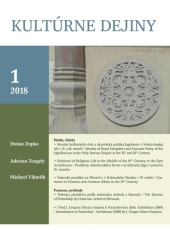Identita kráľovských dcér a dynastická politika Jagelovcov v Svätej rímskej ríši v 15. a 16. storočí
Identity of Royal Daughters and Dynastic Policy of the Jagiellonians in the Holy Roman Empire in the 15th and 16th Century
Author(s): Dušan ZupkaSubject(s): History
Published by: VERBUM - vydavateľstvo Katolíckej univerzity v Ružomberku
Keywords: Jagiellonians; Holy Roman Empire; dynastic identity; royal weddings
Summary/Abstract: The article examines the identity of the Jagiellonian royal princesses on the background of the dynastic policy of the Jagiellonians in the Holy Roman Empire on the verge of the 15th and 16th century. The Jagiellonian princesses became a valuable commodity on the wedding market of this period. The daughters of Polish kings Casimir IV and Sigismund I, and of the Hungarian and Bohemian king Vladislaus benefited from the privilege of possessing both the prestige of the royal dignity and the aura of belonging to a venerable ruling house of Poland and Lithuania. Altogether eight Jagiellonian princesses were married into princely ruling houses of the Holy Roman Empire between 1475 and 1556. This article will examine the identity and dynastic rhetoric of four of them: Hedwig married to Wittelsbachs in Bavaria, Sophie married to Hohenzollern in Brandenburg, Barbara to Wettins in Saxony and Anna to Austrian Habsburgs. The main goal of this article is to show that all of the Jagiellonian Princesses in question developed a double identity. The first one derived from their status as Polish (Hedwig, Sophie, and Barbara), or Hungarian and Bohemian (Anna) royal daughters. The second one, local and acquired, was adopted after their arrival and incorporation to the new court and ruling house. Jagellonian royal daughters were a desired article on the European dynastic market and on the political scene in the late 15th and early 16th centuries. They possessed both the royal rank and the aura derived from belonging to the traditional ruling family in Poland and Lithuania. They therefore had what was lacking by some traditional princes and dukes such as the Wittelsbachs and Welfs (royal rank), and what was missing in other rulers trying to establish a new dynasty, as in the case of Matthias Corvinus or George of Podebrady (dynastic tradition). This was one of the decisive factors that allowed a high demand for Jagiellonian princesses on the late medieval and early modern European wedding market. Numerous descendants of the Polish King Casimir IV Jagiello (1447–1492) and his wife Queen Elisabeth of Habsburg (1454–1505) (married in 1454) gave the dynasty a promising prospect of establishing a widespread network of ruling families and expanding its influence far beyond the Polish-Lithuanian state. Under these conditions, they were considered as potential candidates to become the decisive power in the region, capable of meeting the political expectations of Central Europe. After 1490 the Jagiellonians ruled not only in the Polish-Lithuanian Union, but thanks to the oldest son of Casimir, Ladislaus, they also took over the Hungarian and Czech crowns. Casimir and Elisabeth had 13 children, 11 of whom reached maturity. All five daughters were married to princely houses within the Holy Roman Empire, including some of the most powerful men of contemporary Europe. The same goes for the only daughter of Ladislaus II. Jagiello and Anne of Foix, Anne. In this manner the Jagellonians were married to the most prestigious German and Austrian families, such as the Bavarian Wittelsbachs, the Frankish Hohenzollerns, the Saxon Wettins, and the Austrian Habsburgs. For Krakow, this meant an unprecedented increase in their political influence and introduction on the level of high politics in Central Europe, and especially in the context of the Holy Roman Empire. On the other hand, for most of the German princes, it was a great opportunity to promote their status and glory through marriages with the royal blood of the Jagiellonian princesses. This article examines the dynastic policy of the Jagiellonians towards the Holy Roman Empire on the examples of selected princesses. The choice of sources and the methodology were influenced by two basic boundaries. In the vast majority, it is based on the German sources, respectively, the sources related to Jagiellonian royal daughters, preserved in the German-speaking countries (today‘s Germany and Austria). It focuses primarily on their correspondence, chronicles and other narrative sources. The comparative nature of the study has forced me to narrow the number of protagonists studied. So the focus lies on four princesses. Hedwig, Barbara, Sophia, and Anna, who gradually married to princely families in the Holy Roman Empire between 1475 and 1521. The examination highlights both similarities and differences on the basis of two primary criteria: 1.) establishment in the new environment (identity), and 2.) contact with home and family (dynasty – family). The examination of the comparative material connected to Hedwig, Barbara, Sophie and Anna Jagiellon enables to define common features visible in all four cases. This was the creation of a double or mixed, Polish-German (or, in the case of Anna Jagiellon-Habsburg) identity. All four Jagiellonian princesses under study have quickly established themselves in the new environment. The preserved sources provide repeated evidence that they actively participated in local social, cultural and political life. All four were equal partners of their men. In many cases, during the long absence of their spouses, they also performed regent tasks.
Journal: Kultúrne dejiny
- Issue Year: 9/2018
- Issue No: 1
- Page Range: 6-25
- Page Count: 20
- Language: Slovak

